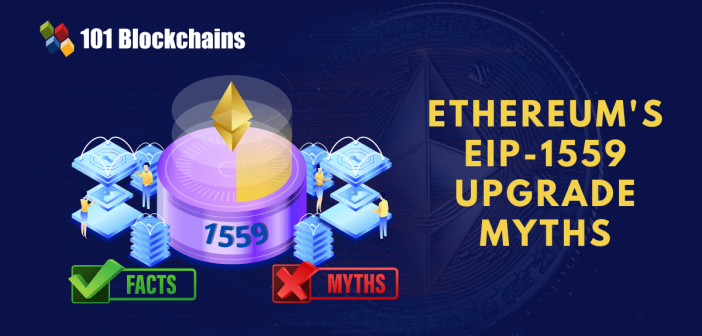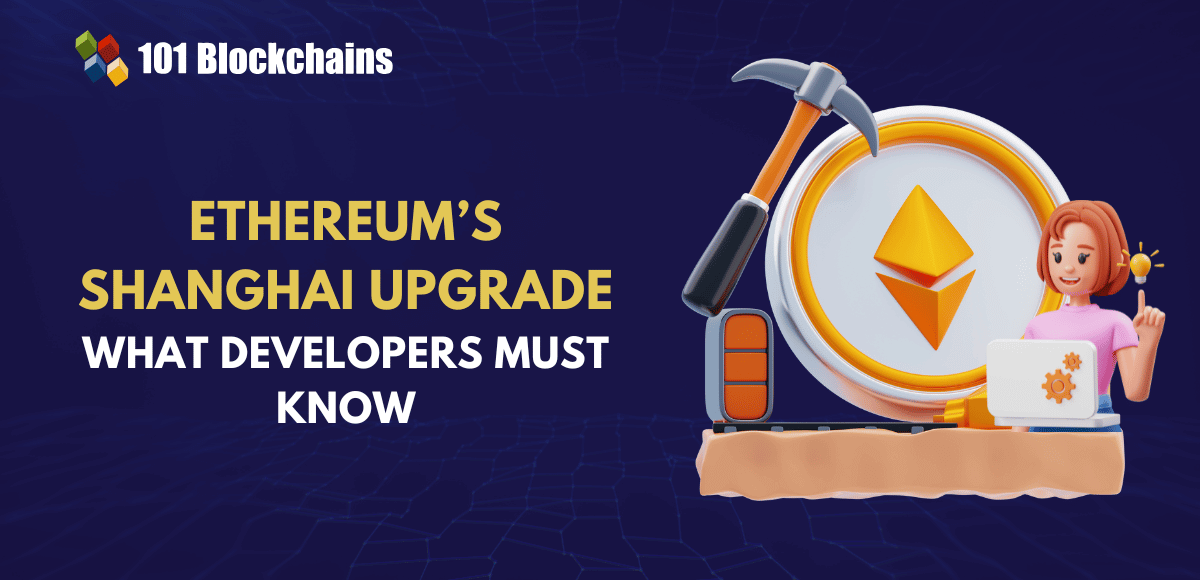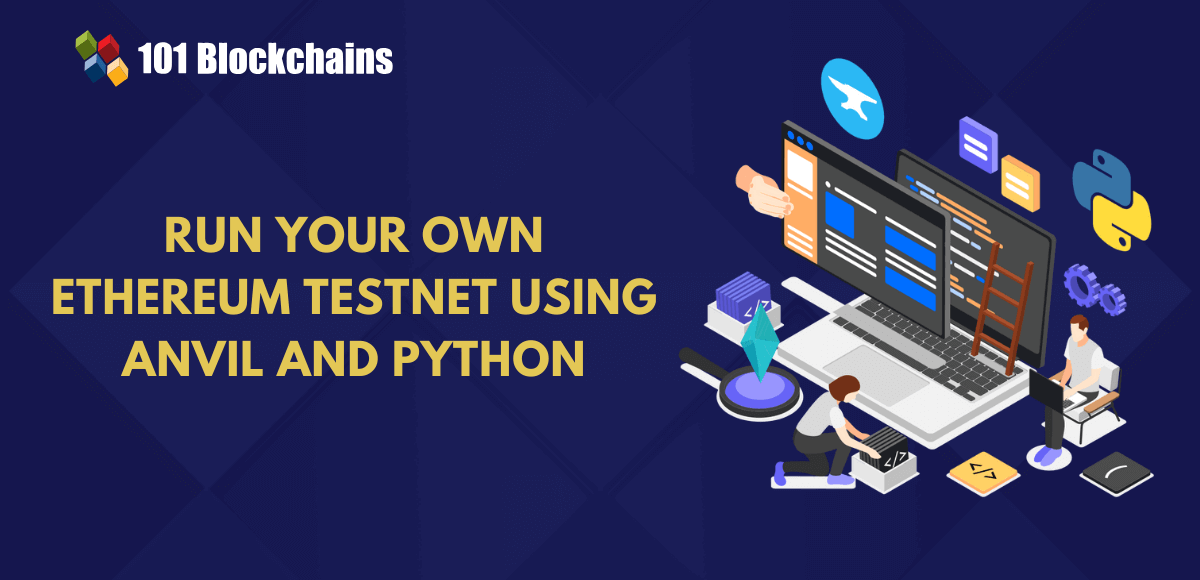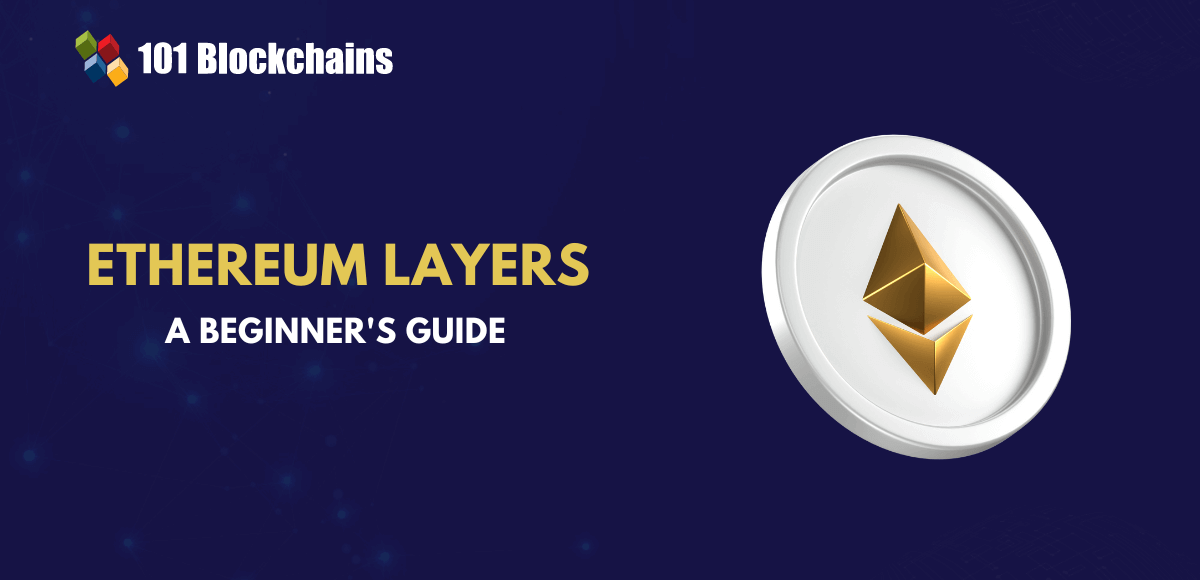Learn how blockchain truly works, master key definitions, and uncover what makes smart contracts so "smart." Dive into the fundamentals, gain valuable insights, and start your blockchain journey today!

- Ethereum
Diego Geroni
- on July 13, 2021
4 Common Myths about Ethereum’s EIP 1559 Upgrade
Confused with the EIP myths all around? Let’s demystify the common EIP myths and the facts behind them.
The rise of virtual asset management has called for radical improvements in recent times. Many people and enterprises have been successful in leveraging the potential of blockchain technology for driving competitive advantage. Most important of all, blockchain applications have achieved many breakthroughs over the years. While people thought that blockchain was only meant for creation of effective virtual currency alternatives, it was capable of far more than that.
The arrival of Ethereum gave the perfect answer to all blockchain skeptics, especially with its ability to enable the development of decentralized applications. The following discussion helps you find EIP 1559 myths. What is EIP 1559? What is its role in Ethereum? Let us reflect on the answers to all these questions for clarifying some myths.
Enroll Now: Ethereum Development Fundamentals Course
Know about the EIP 1559
In order to develop a good understanding of EIP 1559 misperceptions, it is important to understand it first. EIP 1559 is actually an Ethereum Improvement Proposal. The first proposal for EIP 1559 came from the founder of Ethereum, Vitalik Buterin, himself many years ago. EIP 1559 basically aims to change the basic approach for processing transactions.
In the present design, any individual attempting to send transactions on Ethereum has to pay a ‘gas fee’ with a specific transaction. The gas fee paid to Ethereum goes to miners for processing a user’s transactions. Many instances in recent times have shown the extent of volatility in gas fees, especially in times of high transaction demand.
Myths about EIP 1559 upgrade become prominent due to a lack of awareness of the EIP. The EIP 1559 works for changing the existing transaction fee mechanism by introducing a dynamically adjusted base fee. The base fee of each transaction is slated for being burned in comparison to being provided directly to miners.
Users could also add a ‘tip’ for their transaction alongside the base fee for speeding the approval of their transactions. As of now, the EIP 1559 has been deployed live on the Ropsten test network of Ethereum on June 24. In addition, the additional testnet launches on June 30 and July 7 in 2021 would pave the path for launching EIP 1559 upgrade on the official Ethereum mainnet by late July 2021.
Must Read: The Future Of Blockchain Technology – Latest Trends
Discovering the Difference between Myth and Reality for EIP 1559
EIP 1559 is undoubtedly a huge intervention that can change the way the Ethereum network is used. The primary effect of EIP 1559 focuses profoundly on burning the transaction fees rather than sending them to miners. However, the controversies around EIP 1559 in 2021 have started to gain attention primarily due to the lack of information on EIP 1559. The various myths around EIP 1559 require appropriate resolution in order to ensure favorable prospects for the adoption of EIP 1559.
There is no doubt that EIP 1559 is quite a controversial change in the Ethereum ecosystem. Since the first proposal of EIP 1559 in 2019, there have been many EIP 1559 myths regarding its use and effect on investors, end-users, and miners. A detailed overview of common and widely prevalent myths regarding EIP 1559 with relevant explanations could help in finding answers to some common doubts regarding EIP 1559. Here are the most common misconceptions regarding EIP 1559 and the answers to your doubts in a clearly organized manner.
Whether you’re a beginner or an expert in Blockchain, you may have come across one or more of the Blockchain myths. Check out our guide on the most common Blockchain myths and the facts now!
Myth: EIP 1559 Upgrade reduces transaction fees and incentives for miners on Ethereum
The first and foremost entry among EIP 1559 misperceptions points out the capability of EIP 1559 for reducing fees. However, many people are quick to assume that the EIP 1559 upgrade has been solely meant for reducing the transaction fees and incentives for miners on Ethereum.
Want to learn about The Ethereum Technology? Enroll now: The Complete Ethereum Technology Course
Understanding the Fact:
Basically, EIP 1559 has been tailored for reducing the volatility of transaction fees. As a result, EIP 1559 showcases the potential for better predictability of transaction fees through the development of an algorithmic model. The algorithm-based model has been tailored for automatic adjustment of costs by a maximum factor of 1.125x for each block.
According to the existing blind auction mechanism for determining fees on Ethereum adds up volatility in transaction fees. As a result, transaction fees could jump higher considerably within a moment according to the fluctuations in the dApps market.
The EIP 1559 upgrade has been tailored for the regulation of fees on the basis of the use of block space. For example, if blocks have filled up beyond a specific ‘gas target,’ the base fee would grow by 12.5%. Similarly, if the blocks have filled below a specific ‘gas target,’ the base fee would reduce by 12.5%. However, these modifications in the internal working of the transaction fee model on Ethereum would not reduce transaction fees.
Myths about the EIP 1559 upgrade largely point out this outcome of the intervention in the Ethereum fee model, thereby creating misconceptions that it would reduce transaction fees. On the contrary, EIP 1559 solves a prominent issue regarding the pricing of Ethereum transactions.
The problem of higher transaction fees on Ethereum largely emerges from the limited network capacity for processing transactions. It is clearly evident that EIP 1559 would not be capable individually of affecting the number of transactions the network could handle simultaneously. EIP 1559 has made a slight change in the pricing model for transactions on Ethereum with better scope for democratizing control over transaction price.
Enroll Now: Certified Enterprise Blockchain Architect (CEBA) Course
Myth: EIP 1559 is responsible for making Ethereum monetary policy more predictable
The second entry among myths about EIP 1559 in 2021 obviously points out its role in Ethereum monetary policy. Many people have suggested the possibility of EIP 1559 being responsible for introducing predictability in the monetary policy of Ethereum. Slowly, the suggestions have caught fuel in the Ethereum community and are hot topics for debate in present times. However, the negative aspect of such discussion is that they are propagating a myth. So, is EIP 1559 actually responsible for making Ethereum monetary policy more predictable?
Understanding the Fact:
Actually, the answer to such entries in EIP 1559 myths should be evident in the basic functionalities facilitated by the protocol. EIP 1559 could help in introducing a fee-burning mechanism with the capability of removing coins permanently from overall circulating supply of Ether.
The mechanism of burning base fees rather than facilitating their distribution to Ethereum miners comes with a specific implication. The fee-burning mechanism implies the lack of any financial incentives for miners to increase network congestion artificially for escalating the base fee beyond reasonable limits.
The burning mechanism is one of the signature highlights of the EIP 1559 upgrade. As a result, it could help in supporting the adoption of a narrative focused on encouraging limited supply in the investment case for Ether. On the other hand, the difficulty in predicting the amount of Ether that would burn over a specific period of time is also another important highlight.
The answer to myths about the EIP 1559 upgrade related to the predictability of Ethereum monetary policy clearly shows how the fee-burning mechanism is completely unpredictable. As the base fee adjusts dynamically with the network activity and demand for block space, users would have difficulty in predicting the amount of Ether that would burn over a specific period of time for particular transactions.
EIP 1559 definitely brings a counterbalance aspect to fight off a continuously increasing ether supply. However, it doesn’t have the capabilities for improving stability in the long-term monetary policy of Ethereum. As a matter of fact, EIP 1559 focuses on bringing economic instability to the Ethereum network. How? EIP 1559 creates impossible difficulties in controlling the total supply of Ether over the course of time for economic instability. So, it is practically impossible for EIP 1559 to induce predictability of Ethereum monetary policy.
Blockchain is a broad spectrum. Expand your knowledge of Blockchain with this Blockchain Glossary For Beginners.
Myth: EIP 1559 is capable of resolving concerns of MEV or miner extractable value on Ethereum
The most controversial mention among EIP 1559 misperceptions has been associated with the concerns of incentives for miners. One of the most renowned myths regarding EIP 1559 focuses on the protocol’s capability for resolving concerns of MEV or miner extractable value on Ethereum.
Understanding the Fact:
The traditional approach for determining miner revenue on Ethereum largely focuses on a preset block subsidy alongside the transaction fees. On the contrary, the growing popularity of high-frequency trading on decentralized exchanges or DEXs ensures that miner income obtained from MEV is adequately promising. According to an R&D firm, Flashbots, the daily earnings from MEV has increased to over $6 million in June 2021. This indicates a substantial improvement over the value recorded at the beginning of 2021, i.e., around half a million dollars.
MEV is basically the income that miners are earning on the basis of their efforts in arranging transactions in blocks. The complication in quantifying MEV emerged due to various factors. Miner revenue generated from reordering, including or censoring particular transactions in a block, could arrive at any instance when users interact with other users or applications on Ethereum.
The answer to EIP1559 myths that it would reduce the earning of miners must also focus on how it reduces the ability of miners to depend on transaction fees as a means of extracting MEV from users. However, EIP 1559 would not change the ability of miners to arrange transactions and extracting MEV through other avenues. Experts have also pointed out the necessity of introducing further changes in EIP 1559 at a deeper protocol level. In addition, there are still many ways in which EIP 1559 can change Ethereum mining for good.
Also Read: How To Become An Ethereum Developer?
Myth: EIP 1559 would turn miners against the Ethereum network
The final and most critical entry among myths about EIP 1559 upgrade refers to misconceptions that EIP 1559 would turn miners against the Ethereum network. Well, is there any solid evidence to assume the solid ground for such myths?
Understanding the Fact:
As of now, estimates suggest that miners could lose around 20% to 35% of their income through the activation of EIP 1559. At the same time, petitions from mining entities on Ethereum for stopping EIP 1559 clearly showcase the dissent of miners. The petitions have been focused on preventing the implementation of EIP 1559 in the existing form in the London upgrade of Ethereum.
The evidence for EIP 1559 misperceptions focused on dissent of miners also refers to proposals for amendments to EIP 1559. The proposals have presented suggestions for doing away with the burning of the base fee. In addition, the proposals also include the improvement of miner income through different sources such as block subsidies. Furthermore, modifications in the mining algorithm of Ethereum ensure equitability in competition for network rewards.
The answer to such EIP 1559 myths becomes quite clear in the fact that it is all set to go live by July 2021. If a large share of the miner community on Ethereum was opposed to EIP 1559, such a huge decision would not have been possible. With such a huge deployment in the pipeline, it is highly unlikely for miners to resist the London upgrade. Myths and misconceptions are flying here are there with a big EIP 1559 news on the way, especially showing that miners would shut down their machines and compromise the security of Ethereum.
Wouldn’t such types of actions denigrate the basic ethos or founding principles of Ethereum? In addition, you can also find a slew of other reasons to discard the myth of miners going against Ethereum. They wouldn’t just go on to other platforms or attack Ethereum if EIP 1559 comes to play.
Miners might have to discard the rewards they have earned over the years through continuous operations and hardware upgrades. Most important of all, miners do not have adequate runway on Ethereum. So, they would have to let go of all their rewards after it switches to Proof-of-Stake (PoS) protocol next year. So, it is definitely reasonable to think that miners won’t be fighting off the introduction of EIP 1559 in 2021.
Get familiar with common Ethereum terms with the Ethereum flashcards!
Final Verdict
The arrival of EIP 1559 in the Ethereum ecosystem has undoubtedly spurred the arrival of many risks. There is no way to deny the involvement of risks in any change process. However, the Ethereum community has showcased a promising track record in software development and coordination. So, the introduction of a new improvement proposal could definitely overshadow the EIP 1559 myths in the long run.
EIP 1559 emphasizes introducing a better user experience alongside stability in the transaction fee for the Ethereum network. Explanations for myths about EIP 1559 presented here showcase the need for removing the shroud of doubt before adopting change. Learn more about EIP 1559 right now!
Enroll now in our Ethereum Fundamentals Course to know more about EIP 1559!
*Disclaimer: The article should not be taken as, and is not intended to provide any investment advice. Claims made in this article do not constitute investment advice and should not be taken as such. Do your own research!




